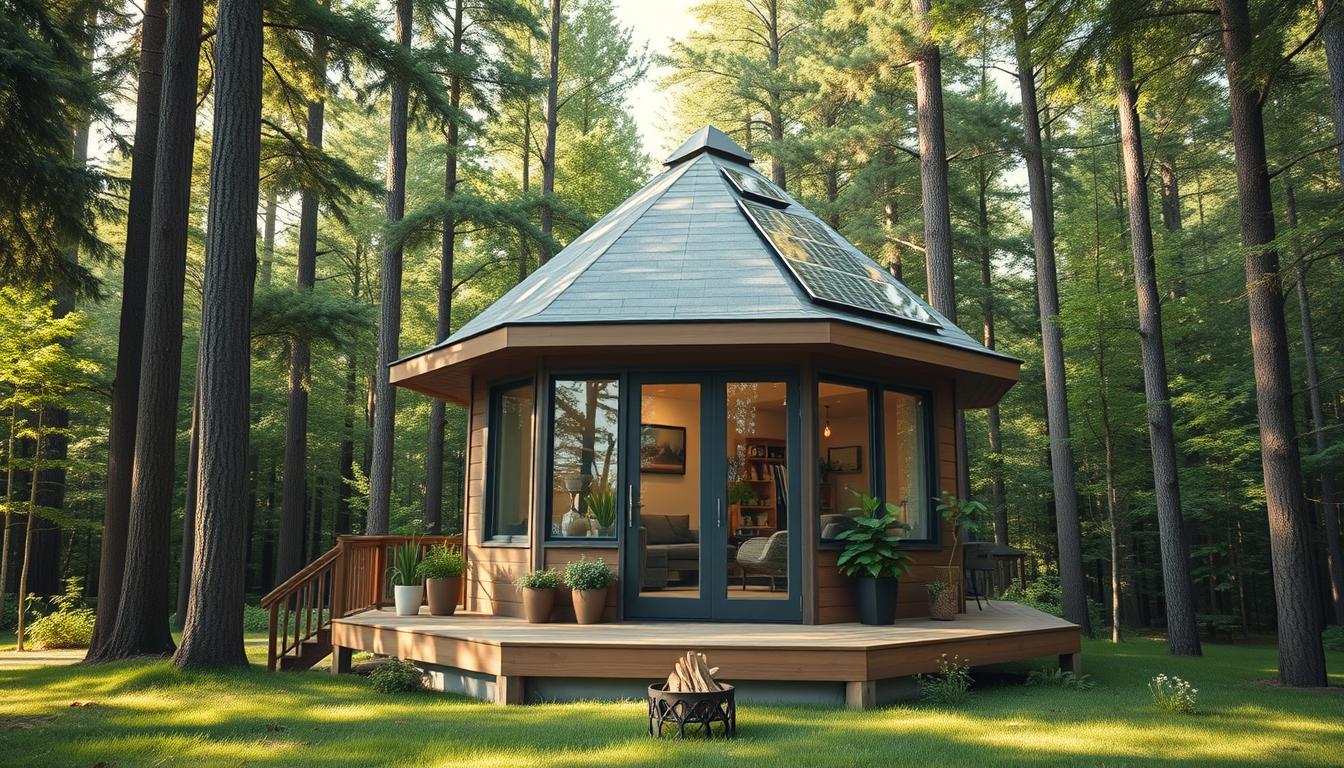The hexagon tiny house is a new way to live small and green. It’s inspired by the hexagonal honeycomb found in nature. This design uses space well and is good for the planet, making it a smart choice for homes.
In the UK, where space and saving the environment matter a lot, this tiny house is very appealing. It’s perfect for those who want a simpler life but still value comfort and style.
These homes are 24 feet long, 8 feet wide, and 13 feet tall. Inside, they have a cozy 250 square feet, including a loft. They’re built to last with red cedar wood and metal roofs.
The structure is strong, thanks to a 2.5mm steel frame and 0.426mm steel roof sheets. Plus, they’re well-insulated to save energy. For more info, check out the Hexagon Tiny House page. It might be the ideal home for you.
Key Takeaways
- The hexagon tiny house design is inspired by nature’s efficient hexagonal patterns.
- This unique compact dwelling maximises interior space while minimising the environmental footprint.
- Materials like red cedar wood cladding and charcoal-coloured metal roofs contribute to the house’s durability and sustainability.
- Key features include a 250 square feet interior, 2.5mm thick profiled steel frame, and 0.426mm steel roof sheets.
- Visit Home of Tiny for more details on this innovative and sustainable micro house.
The Concept of Hexagon Tiny House Living
The tiny house movement has been changed by honeycomb designs. Hexagon tiny houses are now a popular choice for eco-friendly living. They use space-saving ideas, inspired by nature, to make the most of every inch. Each side is about two metres, showing how compact yet useful they can be.
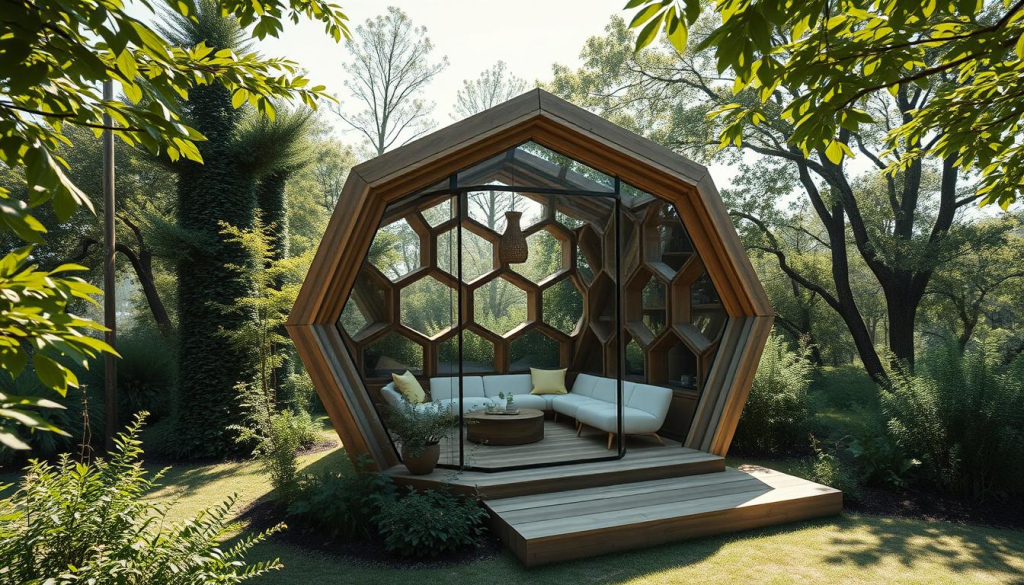
Hexagon tiny houses are cleverly designed. They are strong and last long, thanks to honeycomb structures. This makes them great for homes that save space and are good for the planet. You can also add to or change them as you need, making them very flexible.
These homes are built to last and can handle tough weather. They are perfect for small families, with space for up to three people. Inside, you’ll find everything you need: bedrooms, a kitchen, bathroom, living area, and a small porch, all in a small space.
Hexagon tiny houses also have green features like collecting rainwater. They are affordable, costing less than £15,000. They are easy to move and set up because of their light materials and flat packaging.
The design of hexagon tiny houses is all about being smart and adaptable. They use space well and don’t waste materials. This makes them ideal for those who want to live simply but still have a home that suits their needs.
HIVEHAUS®: A Prime Example of Hexagon Tiny Homes
Barry Jackson’s HIVEHAUS® is a standout in hexagon tiny homes. It uses hexagons for efficient design. Each pod is about 100 square feet, making it easy to create custom homes.
Jackson aims to revolutionise housing by offering structures that do not require foundations and can be quickly assembled, making them an excellent alternative to traditional housing.
HIVEHAUS® is all about being adaptable. You can add or change units as you need. It also uses lots of natural light, thanks to big windows. This makes living there better and helps the planet.
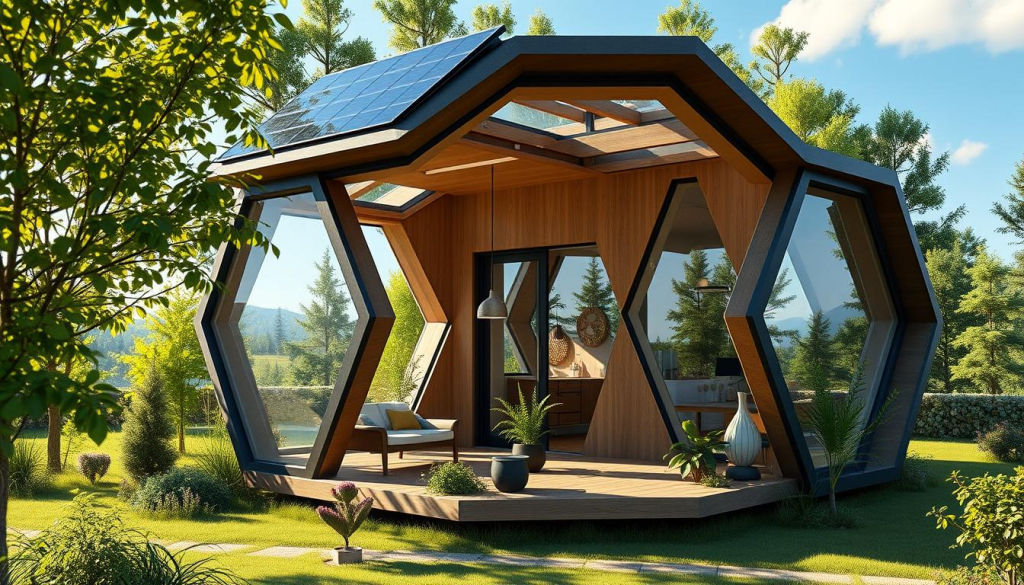
It’s also built with the environment in mind. It uses recycled materials and green roofs. Plus, each pod costs about £10,000, which is cheaper than many UK homes.
HIVEHAUS® makes the most of its space. It has shared areas and bedrooms that use every inch wisely. It looks good too, unlike some modern designs. The white outside could be better, but Jackson is always looking to improve.
There’s now an app to help design your home. It lets you pick materials and see costs. This shows how tech can make building homes easier and more fun.
Sustainable and Eco-Friendly Aspects of Hexagon Tiny Houses
Hexagon tiny houses, like the HIVEHAUS®, use recycled and eco-friendly materials. They are made from old grain bins, reducing waste and saving resources. This approach helps the environment and cuts down on the need for new materials.
These homes focus on living sustainably. Each one has seven hexagons around a central garden. This design helps with growing food, managing water, and using energy wisely.
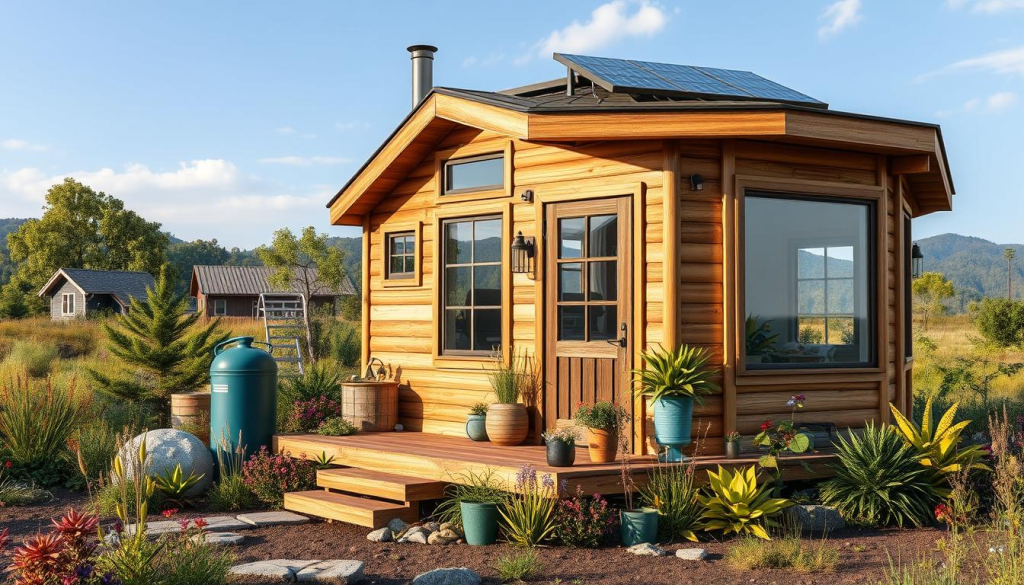
Hexagon tiny houses stand out for their green roofs and natural insulation. These roofs are great for growing food and keeping the house warm or cool. This means less need for artificial heating and cooling, saving energy and money.
They also have smart water systems. These include collecting rainwater and filtering greywater. Plus, they have systems for treating blackwater. This all helps use water wisely.
Energy efficiency is key in these homes. They use natural ventilation and underfloor heating. They can even make their own energy, cutting down on costs and emissions.
The design of hexagon houses is also flexible. You can link them together to create communities. These communities can have shared gardens and spaces for different activities.
In summary, hexagon tiny houses are a symbol of sustainable living. They use recycled materials and focus on saving resources and energy. They offer a complete approach to living green, making them a great choice for those who care about the planet.
Living Off-Grid in a Hexagon Tiny House
Living in a hexagon tiny house means you’re all about being green and free. These homes give you your own water and power, making you totally self-sufficient. You can live in the countryside or a quiet spot in the UK, and still be close to nature.
Hexagonal tiny homes, like HIVEHAUS®, are smartly designed. They mix water and power systems well. Modern tech helps these homes be eco-friendly. For example, solar panels use sunlight for power, and wind turbines help too.
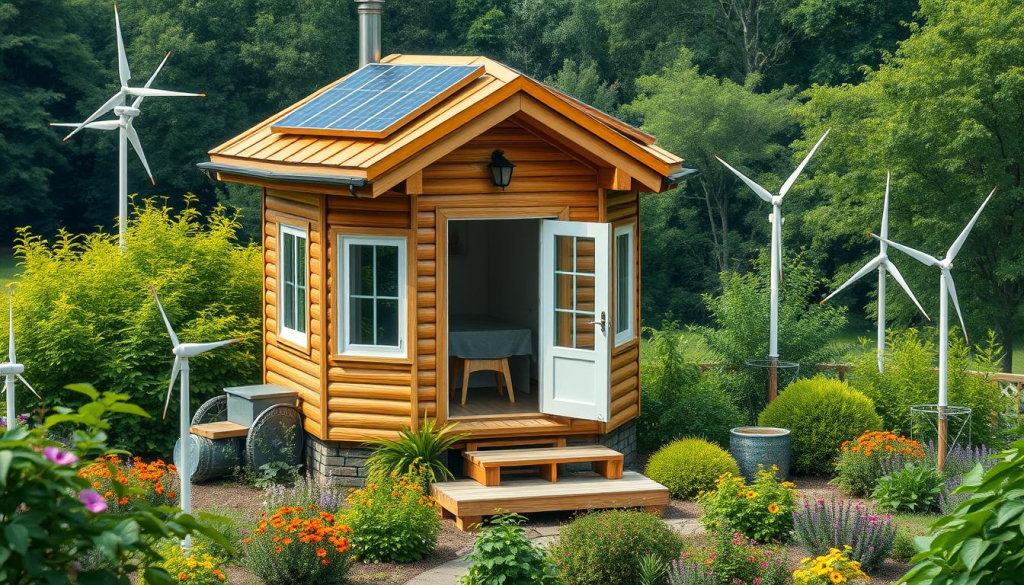
These homes are also great at saving water. They use rainwater systems to collect and clean rainwater. This means you don’t need to use public water, making you even more self-sufficient. Being off the grid saves money and supports a simple, green lifestyle.
-
Solar Panels: These give you power from the sun. They cost a lot at first but save money in the long run.
-
Rainwater Harvesting: It’s a way to get clean water from rain. It’s key for living off the grid.
-
Wind Turbines: They help with power, especially in the UK’s changing weather.
-
Efficient Insulation: The walls and floors keep you warm or cool. This means you use less energy.
Building these homes takes about a year and a half. It shows how careful and detailed the process is. Materials like SIP panels make homes energy-efficient and eco-friendly. They also make building faster and keep your home warm.
Living off-grid in a hexagon tiny house shows you care about the planet. It’s a big step towards using less energy and water.
Exploring Stylish Design Features
Hexagon tiny houses are known for their stylish design. They have wall-to-floor windows that make them feel spacious. These windows let in lots of natural light, making the homes bright and welcoming.
Circular skylights add a modern touch to these homes. They bring in more light and make the homes look great. This feature is a big part of what makes these tiny houses so appealing.
The interior layout of hexagon tiny houses is unique. They use hexagonal shapes to make the most of the space. This design is both modern and practical, making every part of the home useful.
Hexagon tiny houses also feature geodesic domes. These domes are strong and use less resources. They let in natural light and air, making the homes energy-efficient and comfortable.
For more information on stylish tiny homes, check out 101 Tiny Houses that Redefine Compact. It’s a great resource for those interested in modern tiny living.
In summary, hexagon tiny houses are the epitome of stylish, sustainable living. They combine innovative design with practicality. These homes are not just small; they are designed to improve your quality of life.


